Abstract
1 The change in forebrain 5-hydroxyindoleacetic acid (5-HIAA) concentration induced by raphe stimulation has been studied in rats treated with Li+ or 0.9% w/v NaCl solution (saline) for 10 days. 2 Raphe stimulation increased the forebrain concentration of 5-HIAA in both groups of animals. Chlorimipramine abolished this effect in the control group, but not in the Li+ group. 3 The inhibition of 5-hydroxytryptamine (5-HT) uptake by chlorimipramine was not affected by pretreatment with Li+ or by the addition of Li+ to synaptosomal suspensions in vitro. 4 It is suggested that the production of 5-HIAA following raphe stimulation in Li+-treated animals is derived from the metabolism of 5-HT which remains within the intracellular environment. The consequence of this in relation to transmitter release is discussed.
Full text
PDF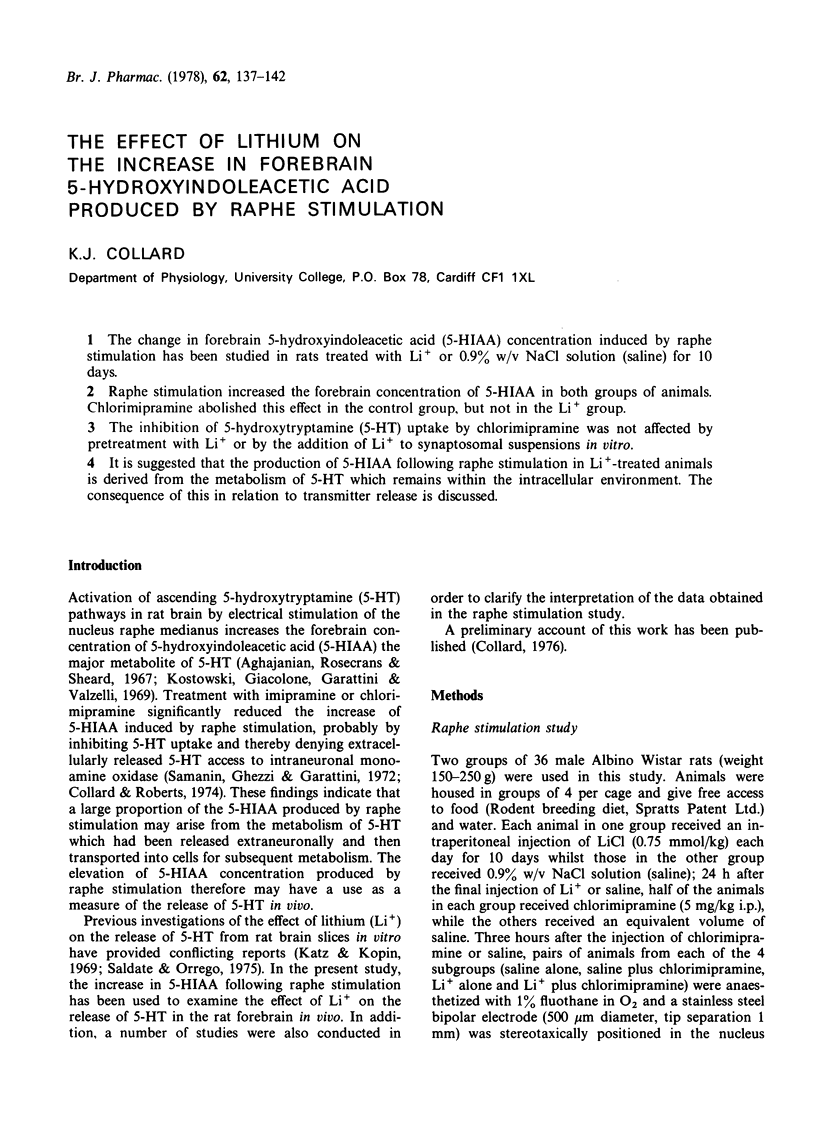
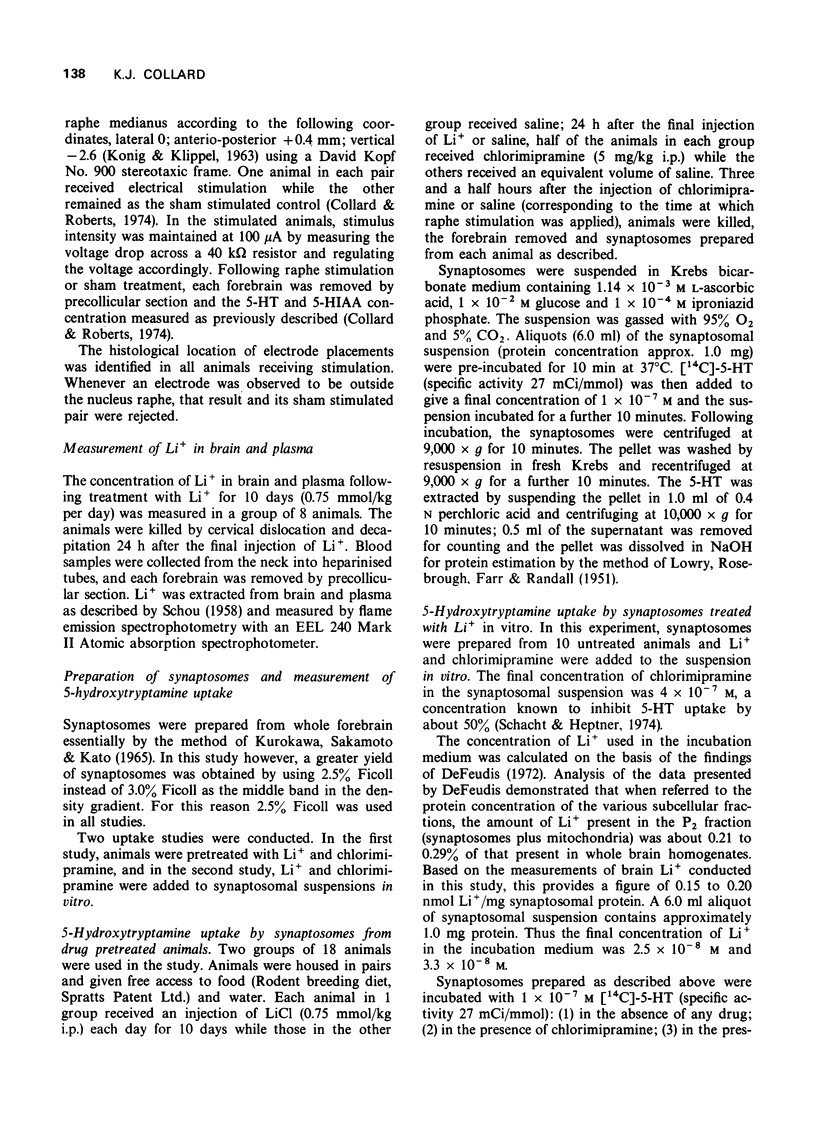
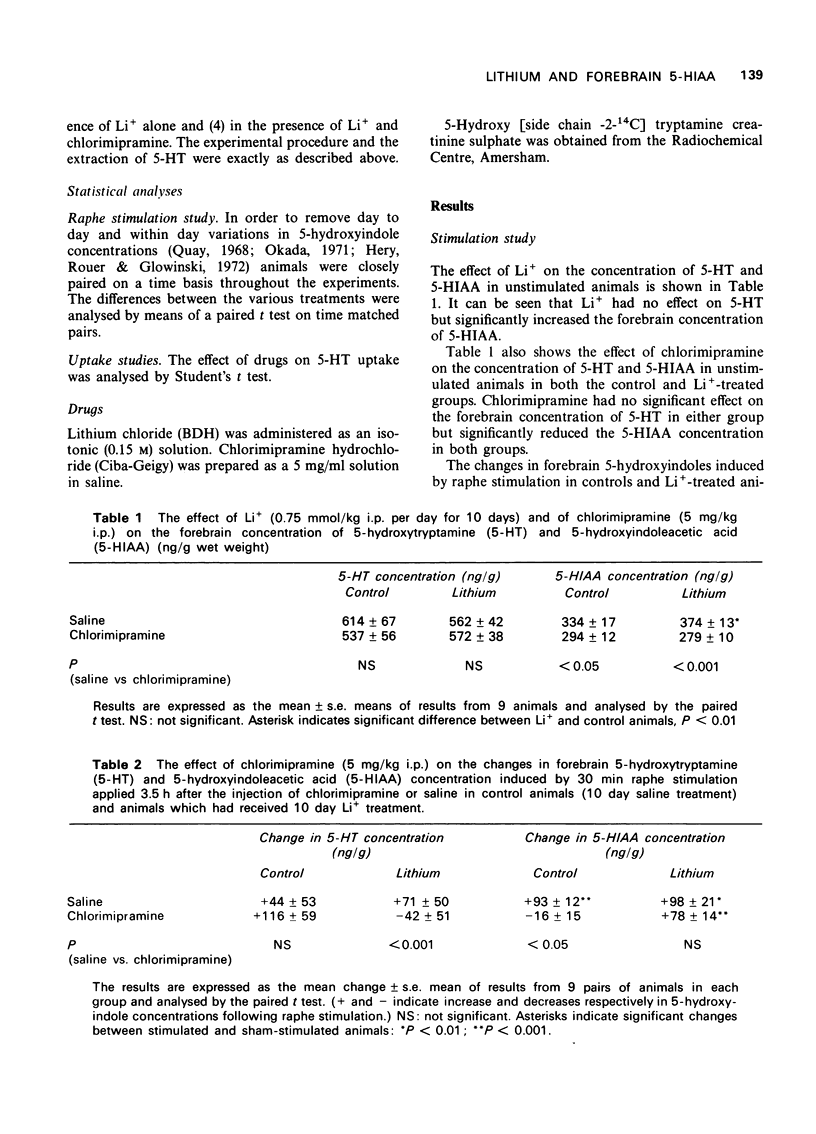
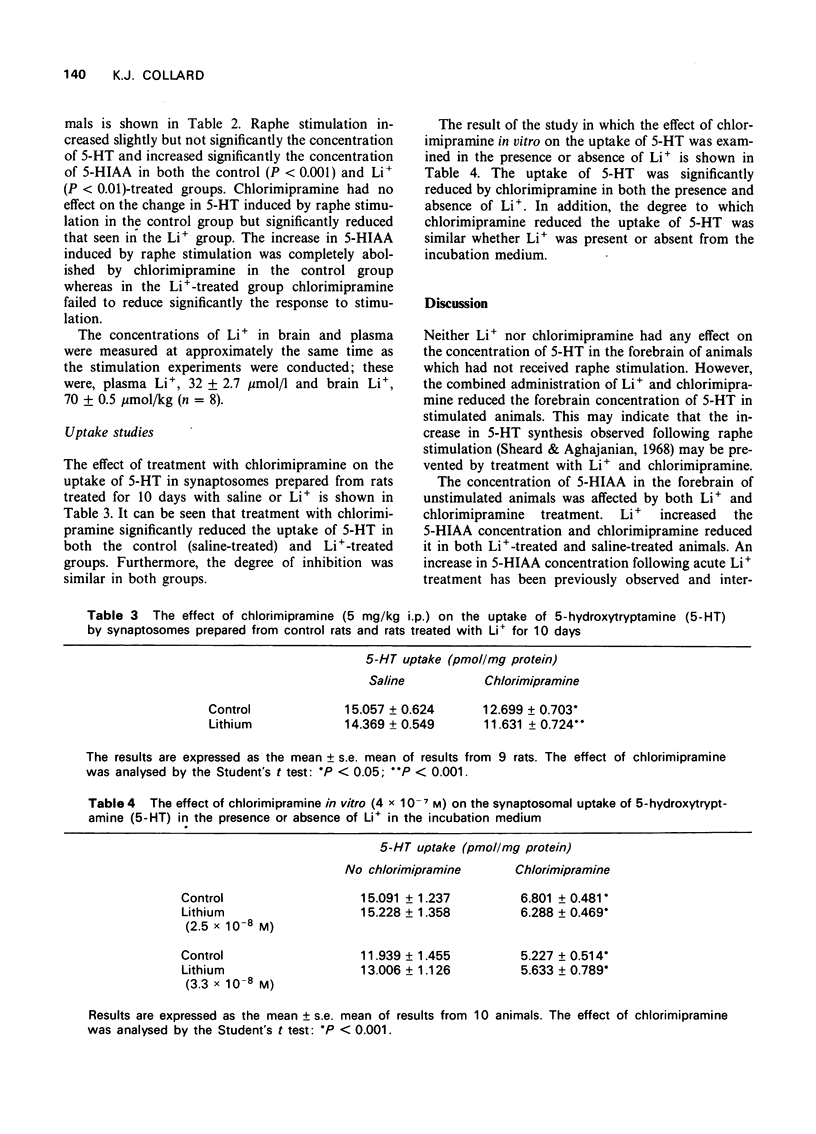
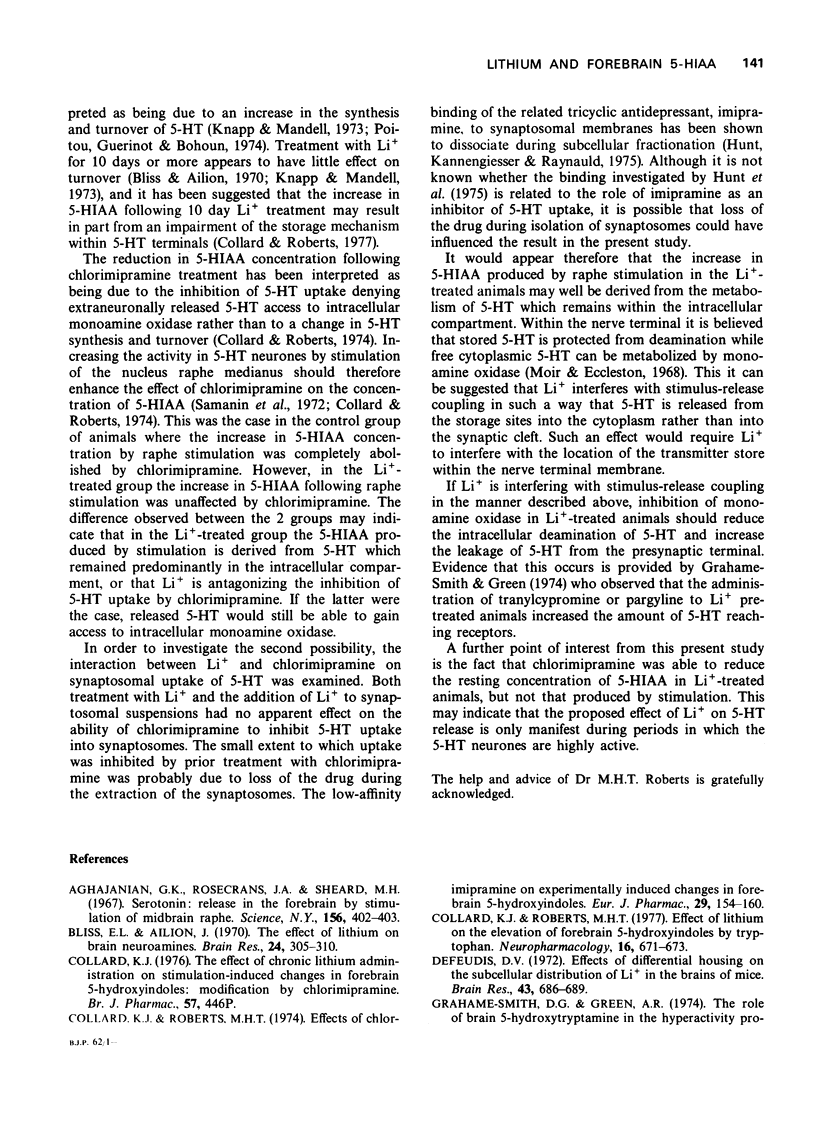
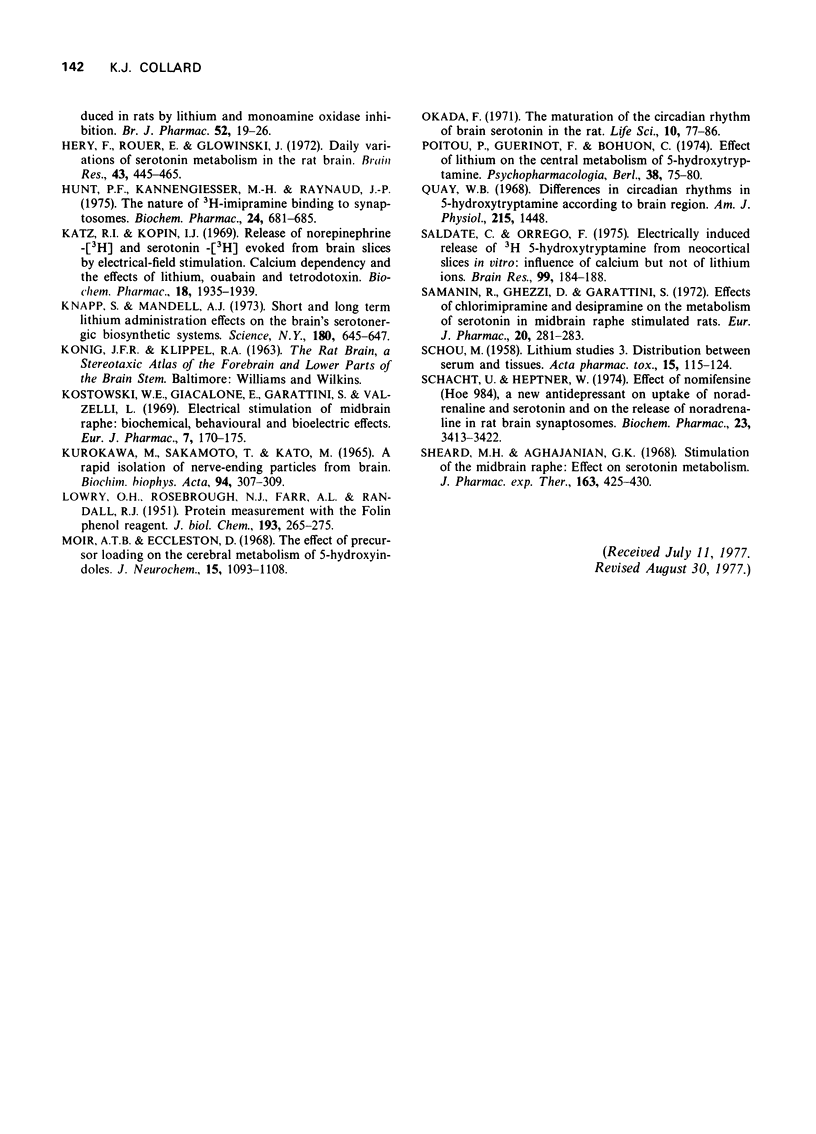
Selected References
These references are in PubMed. This may not be the complete list of references from this article.
- Aghajanian G. K., Rosecrans J. A., Sheard M. H. Serotonin: release in the forebrain by stimulation of midbrain raphé. Science. 1967 Apr 21;156(3773):402–403. doi: 10.1126/science.156.3773.402. [DOI] [PubMed] [Google Scholar]
- Bliss E. L., Ailion J. The effect of lithium upon brain neuroamines. Brain Res. 1970 Dec 1;24(2):305–310. doi: 10.1016/0006-8993(70)90109-5. [DOI] [PubMed] [Google Scholar]
- Collard K. J., Roberts M. H. Effects of chlorimipramine on experimentally induced changes in forebrain 5-hydroxy-indoles. Eur J Pharmacol. 1974 Nov;29(1):154–160. doi: 10.1016/0014-2999(74)90182-4. [DOI] [PubMed] [Google Scholar]
- Collard K. J., Roberts M. H. Effects of lithium on the elevation of forebrain 5-hydroxyindoles by tryptophan. Neuropharmacology. 1977 Oct;16(10):671–673. doi: 10.1016/0028-3908(77)90118-6. [DOI] [PubMed] [Google Scholar]
- Collard K. J. The effect of chronic lithium administration on stimulation-induced changes in forebrain 5-hydroxyindoles: modification by chlorimipramine [proceedings]. Br J Pharmacol. 1976 Jul;57(3):446P–447P. [PMC free article] [PubMed] [Google Scholar]
- DeFeudis F. V. Effects of differential housing on the subcellular distribution of Li + in the brains of mice. Brain Res. 1972 Aug 25;43(2):686–689. doi: 10.1016/0006-8993(72)90431-3. [DOI] [PubMed] [Google Scholar]
- Grahame-Smith D. G., Green A. R. The role of brain 5-hydroxytryptamine in the hyperactivity produced in rats by lithium and monoamine oxidase inhibition. Br J Pharmacol. 1974 Sep;52(1):19–26. doi: 10.1111/j.1476-5381.1974.tb09682.x. [DOI] [PMC free article] [PubMed] [Google Scholar]
- Hunt P. F., Kannengiesser M. H., Raynaud J. P. The nature of (3H)imipramine binding to synaptosomes. Biochem Pharmacol. 1975 Mar 15;24(6):681–685. doi: 10.1016/0006-2952(75)90243-9. [DOI] [PubMed] [Google Scholar]
- Héry F., Rouer E., Glowinski J. Daily variations of serotonin metabolism in the rat brain. Brain Res. 1972 Aug 25;43(2):445–465. doi: 10.1016/0006-8993(72)90400-3. [DOI] [PubMed] [Google Scholar]
- KUROKAWA M., SAKAMOTO T., KATO M. A RAPID ISOLATION OF NERVE-ENDING PARTICLES FROM BRAIN. Biochim Biophys Acta. 1965 Jan 25;94:307–309. doi: 10.1016/0926-6585(65)90036-1. [DOI] [PubMed] [Google Scholar]
- Knapp S., Mandell A. J. Short- and long-term lithium administration: effects on the brain's serotonergic biosynthetic systems. Science. 1973 May 11;180(4086):645–647. doi: 10.1126/science.180.4086.645. [DOI] [PubMed] [Google Scholar]
- Kostowski W., Giacalone E., Garattini S., Valzelli L. Electrical stimulation of midbrain raphe: biochemical, behavioral and bioelectrical effects. Eur J Pharmacol. 1969 Aug;7(2):170–175. doi: 10.1016/0014-2999(69)90006-5. [DOI] [PubMed] [Google Scholar]
- LOWRY O. H., ROSEBROUGH N. J., FARR A. L., RANDALL R. J. Protein measurement with the Folin phenol reagent. J Biol Chem. 1951 Nov;193(1):265–275. [PubMed] [Google Scholar]
- Moir A. T., Eccleston D. The effects of precursor loading in the cerebral metabolism of 5-hydroxyindoles. J Neurochem. 1968 Oct;15(10):1093–1108. doi: 10.1111/j.1471-4159.1968.tb06827.x. [DOI] [PubMed] [Google Scholar]
- Okada F. The maturation of the circadian rhythm of brain serotonin in the rat. Life Sci I. 1971 Jan 15;10(2):77–86. doi: 10.1016/0024-3205(71)90080-4. [DOI] [PubMed] [Google Scholar]
- Poitou P., Guerinot F., Bohuon C. Effect of lithium on central metabolism of 5-hydroxytryptamine. Psychopharmacologia. 1974;38(1):75–80. doi: 10.1007/BF00421289. [DOI] [PubMed] [Google Scholar]
- Quay W. B. Differences in circadian rhythms in 5-hydroxytryptamine according to brain region. Am J Physiol. 1968 Dec;215(6):1448–1453. doi: 10.1152/ajplegacy.1968.215.6.1448. [DOI] [PubMed] [Google Scholar]
- Saldate C., Orrego F. Electrically induced release of (3H)5-hydroxytryptamine from neocortical slices in vitro: influence of calcium but not of lithium ions. Brain Res. 1975 Nov 28;99(1):184–188. doi: 10.1016/0006-8993(75)90625-3. [DOI] [PubMed] [Google Scholar]
- Samanin R., Ghezzi D., Garattini S. Effect of imipramine and desipramine on the metabolism of serotonin in midbrain raphe stimulated rats. Eur J Pharmacol. 1972 Dec;20(3):281–283. doi: 10.1016/0014-2999(72)90186-0. [DOI] [PubMed] [Google Scholar]
- Schacht U., Heptner W. Effect of nomifensine (HOE 984), a new antidepressant, on uptake of noradrenaline and serotonin and on release of noradrenaline in rat brain synaptosomes. Biochem Pharmacol. 1974 Dec 15;23(24):3413–3422. doi: 10.1016/0006-2952(74)90344-x. [DOI] [PubMed] [Google Scholar]
- Sheard M. H., Aghajanian G. K. Stimulation of the midbrain raphe: effect on serotonin metabolism. J Pharmacol Exp Ther. 1968 Oct;163(2):425–430. [PubMed] [Google Scholar]


